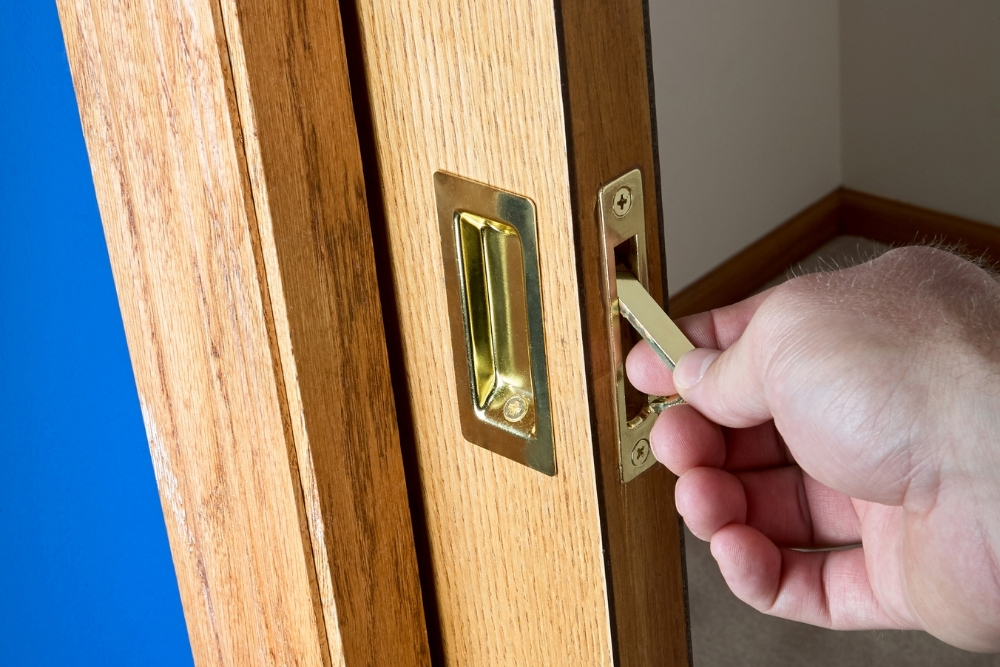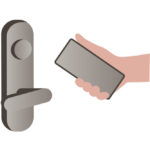We absolutely love pocket doors here at Big Home Reviews. Not only do they look elegant in form and motion, but they’re an amazing space-saver, giving you some vital extra wiggle room in a cramped environment, such as a toilet or pantry.
They’re also a great way to split an established space into discrete sections without resorting to anything as imposing as a new wall and traditional hinged door. You can use them to create a gaming room, an office space, a quiet study hub, or, well…whatever really.
These slick separators simply slide right into a cavity in the adjacent wall, a DIY magic trick — now you see them…now you don’t!

However, the locking of pocket doors is an area of confusion for some. Granted, for many applications, a lock on a pocket door is a little redundant (no one needs a pantry like Fort Knox), but when they’re used as a toilet door, it’s another story entirely.
That’s why we took the time to put this guide on all things pocket door locks to help you understand your options. Let’s get to it!
Passage vs Privacy
A lot of the uncertainty on the topic of pocket doors and their locks is derived from the fact there are two main locking options available, and one of them doesn’t lock the door at all. Well, that’s not strictly true. It’s just that one of them doesn’t lock in a secure, nobody-can-get-in kind of way.
These non-secure devices are referred to as “passage” locks. Their job is simply to hold the door firmly in place. They won’t prevent someone from sliding the door open. As such, they’re a popular choice for laundry rooms, pantries, and closets.
Privacy pocket door locks, on the other hand, do offer that typical locking function we all need when we hit the toilet for some us time. It’s the perfect solution to any situation that requires some privacy.
How Do Passage Pocket Door Locks Work?
Though it looks a little different, you can think of a passage pocket door lock as a typical latch, the kind you’d see on a normal hinged door. The only difference is that it enters its dock directly, rather than sliding into place via the door frame.
It features a little latching bolt or ring section that slots into place, ensuring it doesn’t slide back out again.
To open a pocket door with this type of lock, just pull the door with a small to moderate amount of force. This is the equivalent of pulling down the handle on a traditional hinge door. The latch will become uncoupled from the dock, and the door will slide open.
How Do Privacy Pocket Door Locks Work?
Privacy pocket door locks feature the same latch as passage locks, yet they also have an additional shark fin-like latch protruding from the top of the first.
This fin can also be likened to the latch on a hinged door. The arched shape allows it to slide through the strike plate and into a dock installed above the latch recess, and once in, it cannot be pulled out by force.
To initiate a privacy lock, all you have to do is turn the locking mechanism, then shut the pocket door. You should hear the affirmative click of the shark fin-latch slotting into place, and that’s that — easy, right?
With a hinged door, you’d simply pull the handle to release the latch. To retract the fin-latch of a privacy pocket door lock, just twist the turning lock mechanism that you used to lock the door, in the opposite direction.
Much like a regular lock, some privacy pocket door locks can only be used from within the room they’re blocking access to, but others, such as this Stone Harbor Hardware Lock, give those on the outside an emergency unlock function from the outside too.
This is a great fail-safe to have if you have young children, as you’ll be able to get them out of the room if they accidentally lock themselves in.
However, access from the outside can also be a recipe for trouble, especially if your kids are a little bit older and are just discovering the hilarious world of bathroom pranks. We’ll leave it to your discretion whether fail-safe access is a good idea.
Types of Privacy Pocket Door Locks
There are two main types of privacy pocket door lock to choose from. These are square and rounded, although there are also some higher-end mortise-style locks available, such as this HOMOTEK Privacy Lock.
Square Privacy Pocket Door Locks
Square locks are uniquely shaped, so you’ll need to cut a little notch out of your door to fit them correctly, which means you’re best off installing them in basic door slabs. Any pre-made circular incisions are only going to make things more difficult.
Round Privacy Pocket Door Locks
If you were hoping to renovate an existing door rather than buy a new solid door slab to work on, you’ll need a round privacy lock. They slot into the average 2-⅛-inch hole.
Just remember to check the backset, so you can find a privacy lock with an appropriately sized latch. For those that don’t know, the backset is the distance between the door edge and the middle of the fixture hole.
What About Locking Converging Pocket Doors?
You don’t need any special double pocket door lock to keep your converging pocket doors securely shut. You can use one privacy lock and one receiver, and the doors will lock up just fine.
How To Lock A Pocket Door — Summing Up
Installing a lock on your pocket door can be a little tricky, especially if you prefer a square design, but the actual locking of a pocket door once you’ve got a privacy lock installed is a total breeze.
It’s much like any other keyless lock you’ll encounter in public bathrooms. Simply turn the locking mechanism to release the latch, then slide the pocket door shut — job done!








